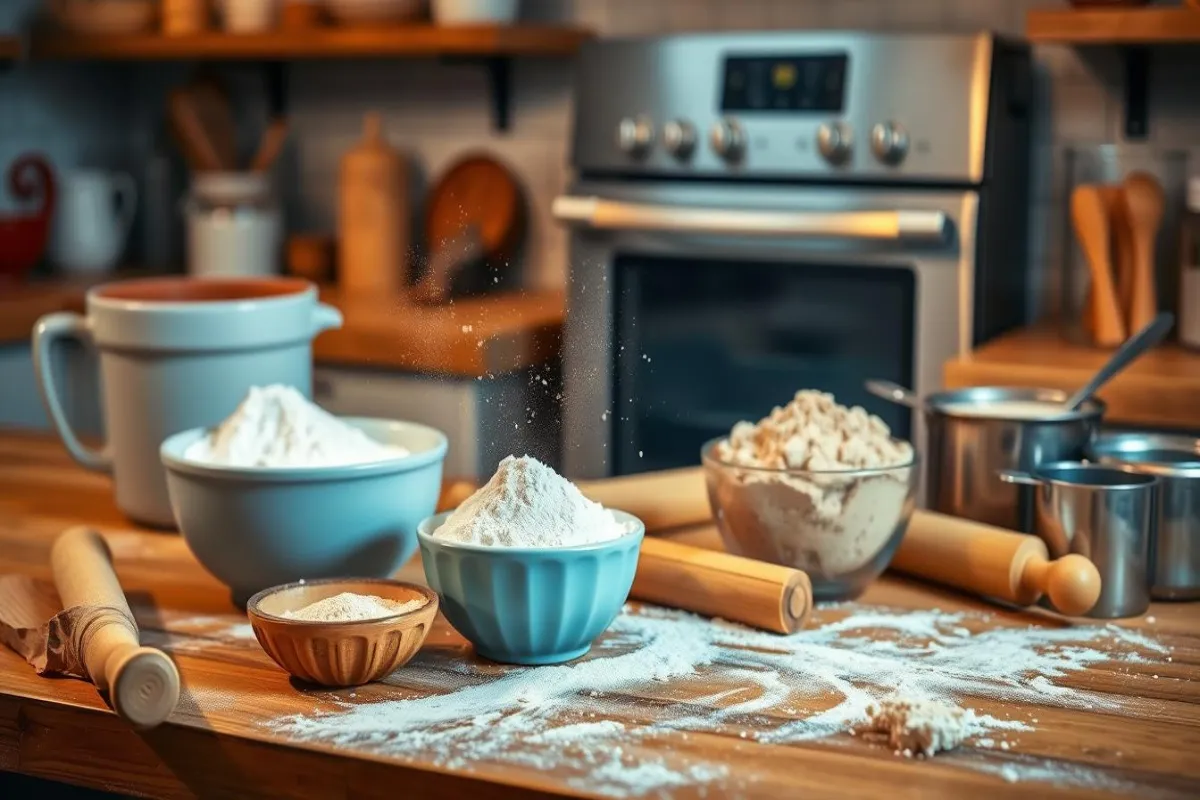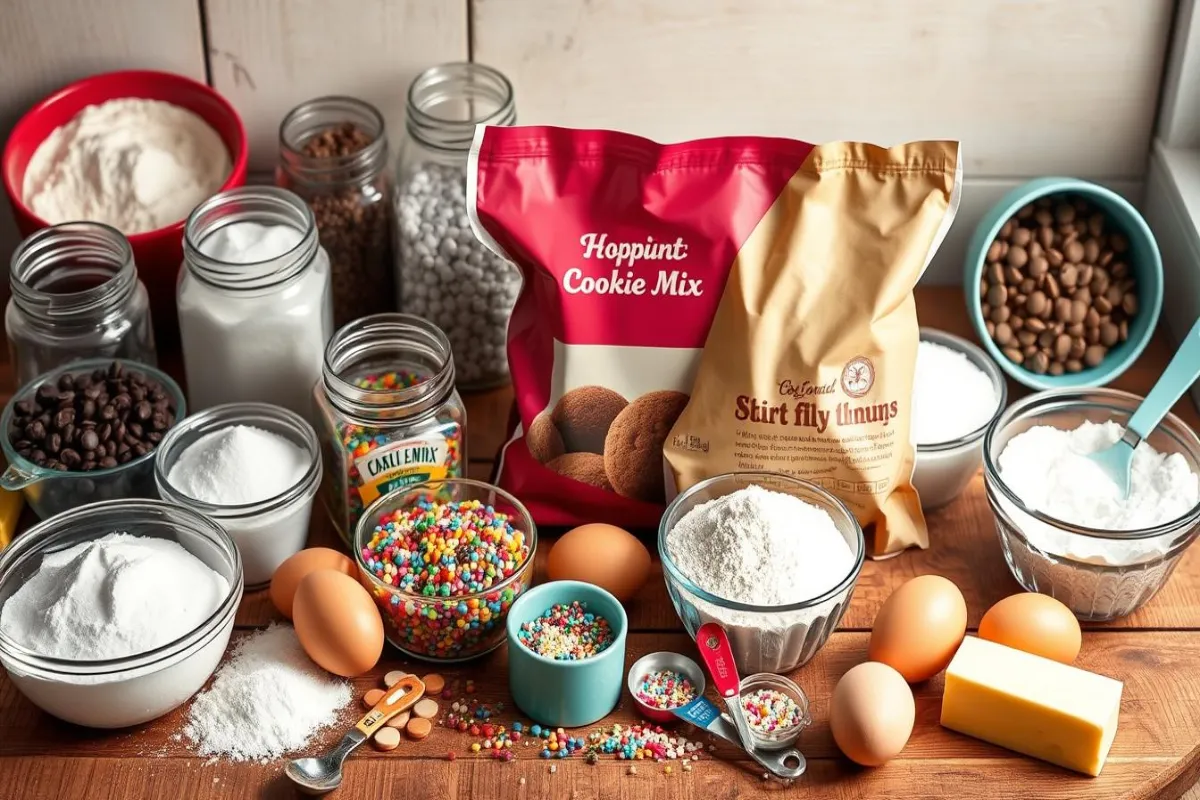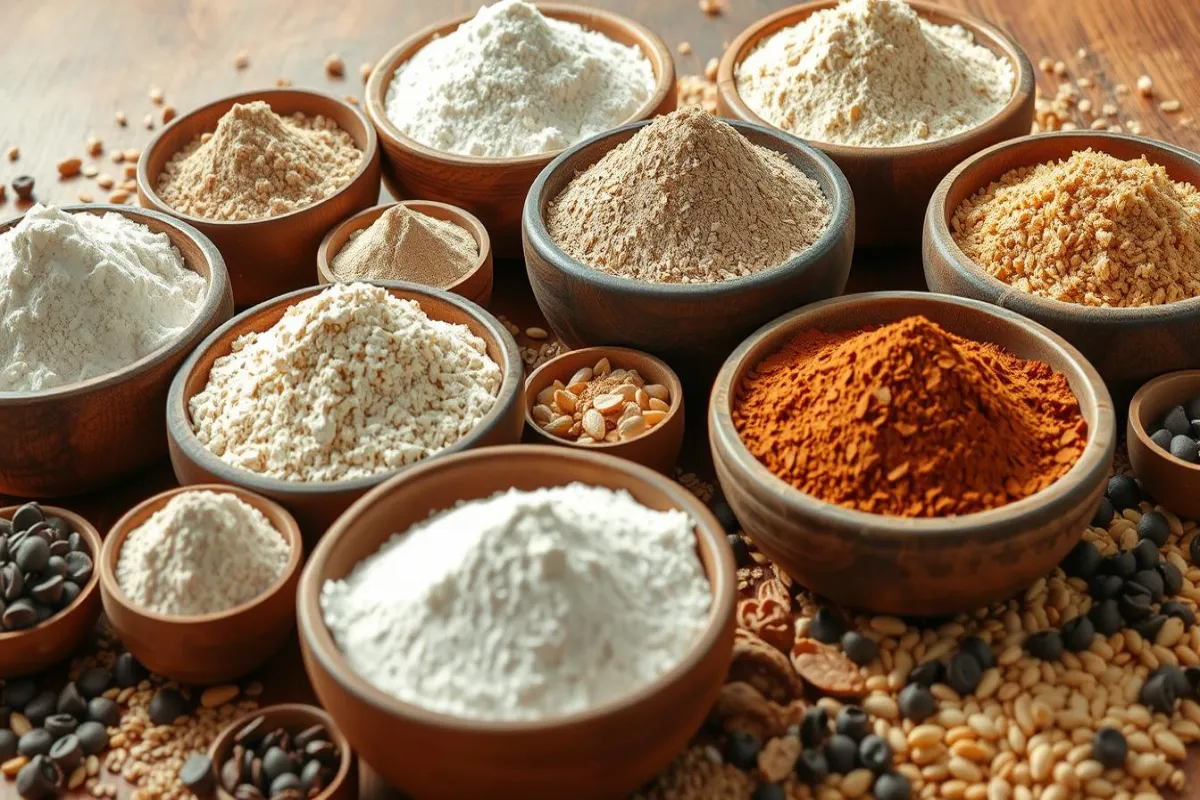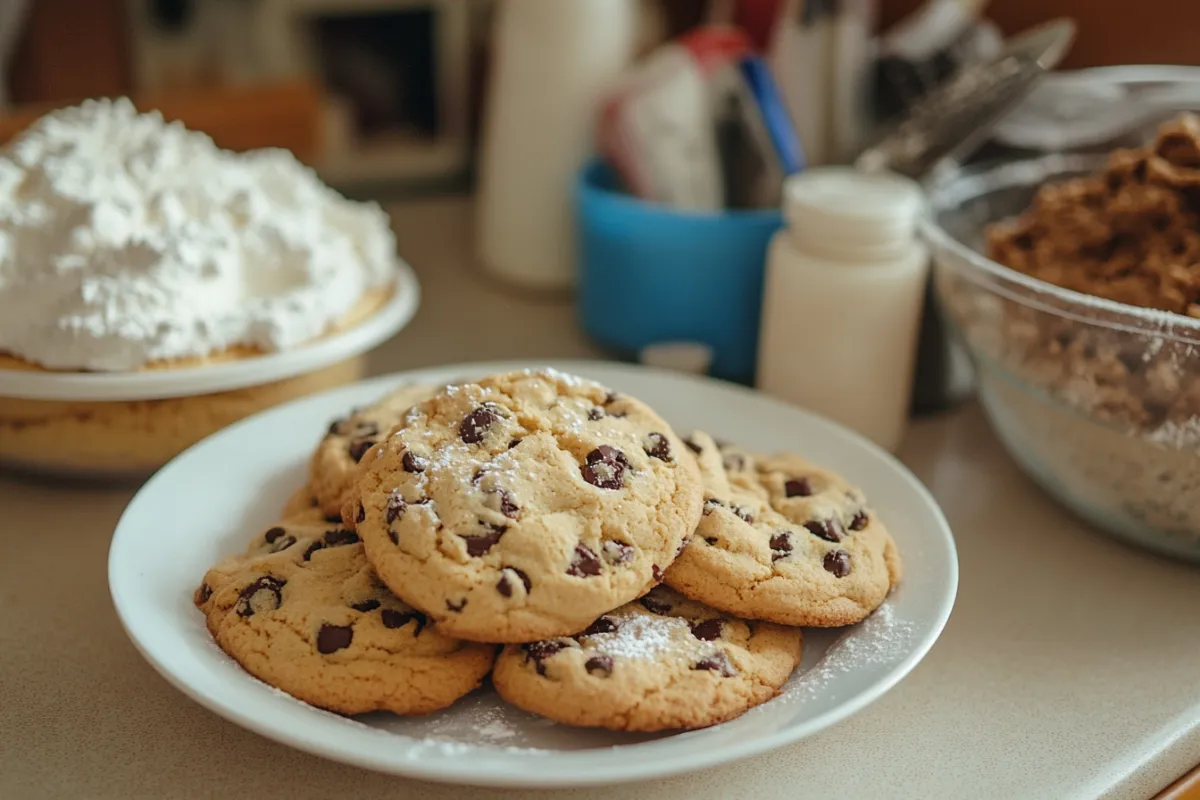Baking with cookie mixes and cake mixes is more than just a taste preference. They have different ingredients, leavening agents, and flour types. This affects their texture and sweetness. Knowing these differences helps you pick the right mix for your baking goals.

Cookie mixes have more fat, like butter or shortening, and less liquid. This makes them denser and chewier. Cake mixes, with more sugar and liquid, are lighter and fluffier.
The flour in each mix is also different. Cookie mixes use all-purpose flour for a firmer texture. Cake mixes use a mix of flours, including cake flour, for a softer crumb.
Exploring the Fundamental Distinctions
In baking, cookie and cake mixes differ in what they’re made of. Cookie mixes have more flour, sugar, and fat. Cake mixes, on the other hand, have a mix of flour, sugar, and leavening agents like baking powder or baking soda.
Composition and Dry Ingredients
Cookie mixes aim for a thick, chewy texture. Cake mixes, however, are made to be light and fluffy. This difference comes from the dry ingredients used in each mix.
Leavening Agents: The Secret to Rise
Leavening agents play a big role in how a mix turns out. Cake mixes use more baking powder or baking soda to rise. Cookie mixes use less, making them denser and chewier.
| Ingredient | Cookie Mix | Cake Mix |
|---|---|---|
| Flour | Higher proportion | Moderate proportion |
| Sugar | Higher proportion | Moderate proportion |
| Fat | Higher proportion | Lower proportion |
| Leavening Agents | Lower concentration | Higher concentration |

“The key to understanding the difference between cookie and cake mixes lies in their distinct dry ingredient compositions and leavening agent ratios.”
Flour Blends: The Foundation of Baking
Cookie mixes and cake mixes rely heavily on flour blends for texture and structure. Cookie mixes often use a mix of all-purpose flour and specialty flours. Cake mixes, however, need a finer flour blend for a tender crumb.
Flour blends are essential in baking. They combine different flours like all-purpose, cake, and pastry flour. This mix creates the perfect balance of structure, rise, and mouthfeel in baked goods.
All-purpose flour gives baked items structure and support. Cake flour makes cakes soft and tender. Pastry flour is used in cookies for a tender, crisp texture.
Knowing how flour blends work helps bakers achieve the right texture and structure. Whether making chewy cookies or light cakes, finding the right flour mix is key. It ensures a perfect balance of flavors and textures.

“The quality of flour can make or break a baked good. It’s the foundation upon which all the other ingredients build.”
Flour blends are the backbone of baking. They determine the outcome of cookie and cake mixes. By understanding each flour’s unique properties, bakers can create delicious treats that please the palate.
Preparation Methods: The Key to Texture
How you prepare cookie and cake mixes greatly affects their texture. Cookie mixes need a hands-on approach for mixing and kneading. This helps develop the gluten structure. On the other hand, cake mixes require a gentler touch to avoid a tough, dense texture.
Mixing Techniques and Consistency
Making cookie dough involves vigorous mixing. This ensures all ingredients are well combined and gluten is developed. This leads to a chewier texture, typical of cookies. Cake mixes, however, need a lighter touch to prevent a tough crumb. The aim is to balance mixing so the leavening agents can create a soft, fluffy texture.
The final batter or dough consistency also affects texture. Cookie mixes result in a thicker, pliable dough. Cake mixes yield a thinner, pourable batter. This difference in consistency is key to the final texture of baked goods.
“Proper preparation is the key to unlocking the perfect texture in baked goods.”
Understanding the preparation methods for cookie and cake mixes is crucial. It helps you achieve the texture you want in your baking.
Sweetness Levels: A Delicate Balance
Cookies and cakes have different sweetness levels that make them unique. Cookies are known for their sweet taste and have more sugar than cakes. This extra sugar helps them get that golden-brown color and crispy texture.
Cakes, on the other hand, have a balanced sweetness. This lets other flavors like vanilla, chocolate, or fruit stand out. This balance makes cakes great for many occasions and tastes.
| Attribute | Cookies | Cakes |
|---|---|---|
| Sweetness Levels | Higher sugar content | More balanced sweetness |
| Caramelization | Pronounced caramelization during baking | Caramelization is less prominent |
| Flavor Profiles | Sweetness is the dominant flavor | Other flavors, such as vanilla, chocolate, or fruit, can shine through |
Finding the right sweetness is key for both cookies and cakes. Knowing these differences helps bakers make treats that please many. They can create flavors that satisfy everyone’s sweet tooth.
“The perfect cookie strikes a balance between sweet and savory, with just the right amount of crunch and chew.”
Egg Usage: A Binding and Enriching Ingredient
Eggs are key in cookie and cake mixes. They help shape the texture and structure of these treats. Cookies might use fewer eggs or none at all. But cakes need eggs to be soft and tender.
The Role of Eggs in Baking
Eggs do many things in baking. They make a big difference in the final product. In cookies, eggs make them delicate and crumbly.
Cakes, however, get a smooth, velvety crumb from eggs. They also add richness and flavor. Plus, eggs help the cake keep its shape while baking and cooling.
| Ingredient | Cookie Mix | Cake Mix |
|---|---|---|
| Eggs | Fewer or none | Crucial binding and enriching agent |
| Texture | Delicate and crumbly | Soft and tender |
| Richness | Less pronounced | Richer mouthfeel and flavor |
Eggs are very versatile in baking. They are essential for the right texture and taste in cookies and cakes.
Baking Times and Temperatures
Baking is a mix of art and science. The right time and temperature are key to success. Cookies and cakes need different times and temperatures because of their unique textures and tastes.
Cookies bake fast at high temperatures. This makes them crispy on the outside and soft inside. Cakes, however, bake slower at lower temperatures. This ensures they are moist and fluffy.
| Baked Good | Baking Temperature Range | Baking Time Range |
|---|---|---|
| Cookies | 350°F to 375°F (175°C to 190°C) | 8 to 12 minutes |
| Cakes | 325°F to 350°F (165°C to 175°C) | 25 to 45 minutes |
To get the best results, you need to know your ingredients and what you want to achieve. By paying attention to baking times and temperatures, you can make your baked goods perfect every time.
When you’re baking, knowing the difference between cookie and cake mixes is key. These mixes have different ingredients, leavening agents, and ways to bake. This knowledge helps you get the right texture and taste in your treats.
Composition and Dry Ingredients
Cookie mixes have more fat, like butter or oil, than cake mixes. This makes cookies chewier and cakes lighter and fluffier.
Leavening Agents: The Secret to Rise
Cake mixes have more leavening agents to make them rise and be airy. Cookie mixes have less, making them denser and chewier.
Flour Blends: The Foundation of Baking
The flours in cookie and cake mixes also differ. Cake mixes use more all-purpose or cake flour. Cookie mixes might use a mix of flours for a unique texture.
| Characteristic | Cookie Mix | Cake Mix |
|---|---|---|
| Fat Content | Higher | Lower |
| Leavening Agents | Less | More |
| Flour Blend | Varied | Predominantly all-purpose or cake flour |
| Texture | Chewier | Lighter and more spongy |
The differences between what’s the difference between a cookie mix and a cake mix? are many. They affect the taste and texture of your baked goods. Knowing these differences helps you bake better.
Texture Differences: From Tender to Dense
Cookies and cakes have different textures because of their ingredients and how they’re made. Cookies are dense, chewy, and crisp. Cakes, on the other hand, are lighter, more tender, and airy. The mix of ingredients and how they’re mixed up is key to the final texture.
The Impact of Ingredients on Texture
The ingredients in cookie and cake mixes affect their texture a lot. Cookies have more fat and sugar, making them denser and chewier. Cakes, with more flour and leavening agents, are lighter and tender.
How these ingredients are mixed also matters. Cookies need a careful mix for the right chewiness. Cakes need a mix that incorporates air well for their light and fluffy texture.
| Ingredient | Cookies | Cakes |
|---|---|---|
| Fat | Higher proportion | Lower proportion |
| Sugar | Higher proportion | Lower proportion |
| Flour | Lower proportion | Higher proportion |
| Leavening Agents | Lower proportion | Higher proportion |
Knowing how ingredients affect texture helps bakers choose and mix better. This way, they can get the baking results they want.
Versatility in Baking: Cookies vs. Cakes
Both cookie mixes and cake mixes are very versatile in baking. They may seem different, but they can open up a world of possibilities for home bakers.
Cookie mixes can make many kinds of cookies. You can make everything from classic chocolate chip to unique flavors like peanut butter or oatmeal raisin. Just a few extra ingredients can turn a basic mix into a special treat. This makes cookie mixes great for any occasion or taste.
Cake mixes are also very flexible. They’re not just for layer cakes. You can make delicious sheet cakes, moist cupcakes, and even fancy tiered cakes. Cake mixes let bakers get creative and make special desserts for any event.
Whether you want to bake cookies or a big cake, these mixes offer endless options. With a bit of creativity and some extra ingredients, home bakers can impress everyone with their tasty creations.
| Attribute | Cookies | Cakes |
|---|---|---|
| Texture | Typically crisp or chewy | Soft, moist, and tender |
| Serving Size | Individual portions | Sliced or portioned pieces |
| Baking Time | Generally shorter | Typically longer |
| Versatility | Wide range of shapes, sizes, and flavors | Diverse options for layer cakes, sheet cakes, and cupcakes |
Dietary Considerations: Gluten-Free and Vegan Options
Baking has changed a lot, especially for those with dietary needs. Now, you can find gluten-free and vegan cookie and cake mixes. These mixes use special flours and ingredients to make tasty treats without gluten or animal products.
For those who can’t eat gluten, these mixes are a big help. They use flours like rice flour, almond flour, or tapioca starch. This way, they taste and feel like regular baked goods.
Vegan baking has also become popular. Vegan mixes don’t have dairy or eggs. Instead, they use soy milk, coconut oil, or flax or chia seeds as substitutes. This makes delicious treats for vegans without losing the fun of baking.
“Dietary restrictions no longer mean giving up on the joys of baking. Thanks to the innovative gluten-free and vegan options available in cookie and cake mixes, everyone can enjoy the comforting flavors of homemade baked goods.”
Now, whether you’re gluten-free, vegan, or just want to bake for others, there’s something for you. The baking aisle is full of options that meet different dietary needs. This makes baking fun and welcoming for everyone.
Storage and Shelf Life: Keeping Baked Goods Fresh
Keeping cookie mixes and cake mixes fresh is important. The right storage can make a big difference. Temperature, humidity, and packaging all affect how long they stay good.
For cookie mixes, keeping them fresh is key. Store them in an airtight container at room temperature. Keep them away from sunlight and heat to prevent drying out.
Cake mixes need a bit more care. They are sensitive to their environment. Store them in a cool, dry place like a pantry. This helps keep the ingredients from clumping.
| Product | Ideal Storage Conditions | Approximate Shelf Life |
|---|---|---|
| Cookie Mixes | Airtight container, room temperature, away from heat and sunlight | 6-12 months |
| Cake Mixes | Cool, dry place (pantry or cabinet), away from moisture | 6-12 months |
By following these tips, your baked goods will stay fresh longer. This means they’ll taste better and have a better texture.
“Proper storage is the key to preserving the quality and taste of your homemade baked goods.”
Conclusion
The main differences between cookie mixes and cake mixes are in their ingredients and how they are made. Cookie mixes have special ingredients that make them chewy and sweet. Cake mixes, on the other hand, are light and fluffy.
Knowing the differences helps you choose the right mix for your baking needs. Whether you love cookies or cakes, this knowledge lets you make perfect treats. It’s all about finding what you enjoy most in your baked goods.
As you keep baking, remember that cookies and cakes can be mixed and matched. You can create amazing desserts by combining their best qualities. Start experimenting and watch your baking skills grow. Enjoy the journey and the delicious results.
FAQ
Cookie mixes and cake mixes differ in many ways. Cookie mixes have more flour, sugar, and fat. Cake mixes have a special blend of flour, sugar, and leavening agents. This makes cookies dense and chewy, while cakes are light and fluffy.
Cookie mixes have more flour, sugar, and fat. Cake mixes have a mix of flour, sugar, and leavening agents. This helps cakes rise and become light and airy.
Leavening agents like baking powder and baking soda are key in cake mixes. They make cakes light and fluffy. Cookie mixes have less of these agents, making them denser and chewier.
The flour blends in cookie mixes and cake mixes affect the texture. Cookie mixes use a mix of all-purpose flour and specialty flours. Cake mixes use finer, more delicate flours for a tender crumb.
Preparing cookie mixes and cake mixes differently affects the texture. Cookie mixes need thorough mixing and kneading. Cake mixes require gentle mixing to avoid toughness.
Cookie mixes are sweeter due to more sugar. This gives them a sweeter flavor and caramelization. Cake mixes have balanced sweetness, letting other flavors stand out.
Cookies often use fewer eggs or none at all. Cakes use eggs for binding and richness, making them soft and tender.
Cookies bake at high temperatures for short times. Cakes bake at lower temperatures for longer to ensure moistness and fluffiness.
Cookies are dense, chewy, and crisp. Cakes are light, tender, and airy. The ingredients and how they’re mixed determine the texture.
Cookie mixes can make many types of cookies. Cake mixes are great for layer cakes, sheet cakes, and cupcakes. These mixes let bakers be creative and meet different needs.
Now, there are gluten-free and vegan options for both mixes. These use special flours and substitutes for those with dietary restrictions.
Storing and handling mixes properly keeps baked goods fresh. Temperature, humidity, and packaging are key to maintaining quality.

